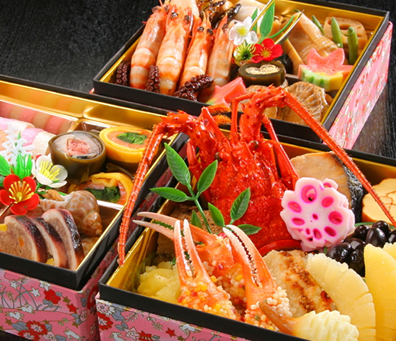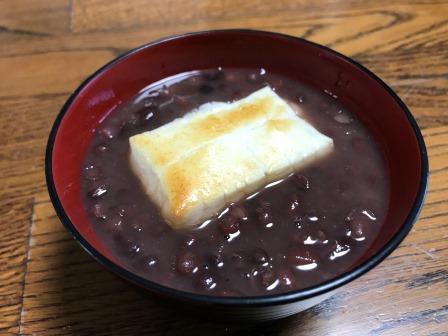6 END OF YEAR FOODS YOU MUST EAT TO RING IN THE JAPANESE NEW YEAR (and where to find them)
The holidays are among us, a time for family and celebration. It might come as a surprise to you that Christmas isn’t truly celebrated here in Japan. Christmas is a time for couples, not family gatherings, to go on a date and look at the astounding Winter Illuminations. So what about New Years’ holiday then?
The most significant holiday celebrated in Japan IS New Year. Streets are empty as stores, and even supermarkets close down. Everyone returns to their hometown, gathering around great food, watching the countdown tv programs, and visiting Shrines, wishing good luck as they ring in the Year to come.
As the streets quiet, the Shrines become hectic with lengthy lines for people to pay their respects and wish for a great year. Other unique traditions to celebrate a Japanese New Year are watching the first sunrise, deep cleaning your home before the 1st of the Year, and shopping all the New Year’s sales by grabbing a ‘surprise bag’ called a Fukubukuro. Yet the best tradition of all must be the FOOD!
Since everyone returns to their hometown and restaurants, cafes, and grocery stores are closed, gathering around home cooking is the most significant way to celebrate the New Year. There are no turkeys or charcuterie boards here, but food that dates back to the Heian period (794) and has been prepared the same Year after Year. A time for nostalgia. What a fantastic opportunity to be in Japan, to be able to take part in such a tradition that hasn’t changed for centuries!
So jump in and celebrate the New Year the Japanese way with these Top 6 Must Eat Foods:
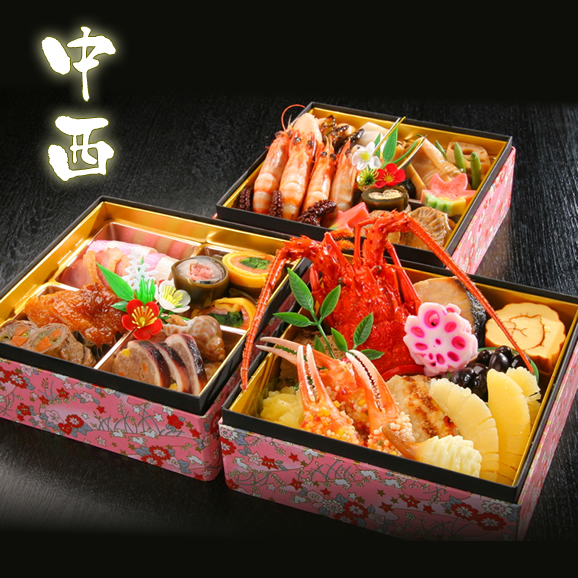
1. OSECHI RYORI
Everything in Japan has a significant meaning, not all Shrines and Temples are the same, and you visit different ones depending on what fortune you would like. Osechi is just the same. Osechi is a bento box-like food boasting separate compartments of food that have been specifically crafted for the New Year, each holding a special meaning. Family, mainly the mothers, start preparing the Osechi the week leading up to New Year. Then these gorgeous boxes called jubako, are stacked beautifully in the middle of the table from New Year’s Eve through Jan 1 for the entire family to enjoy. Since dating back to the Heian period, when refrigerators weren’t present, most of these foods use many Japanese main ingredients (Soy sauce, Sake & Mirin), allowing them to sit out on the table and not need to be kept cool.
Let’s take a look inside some of these boxes:
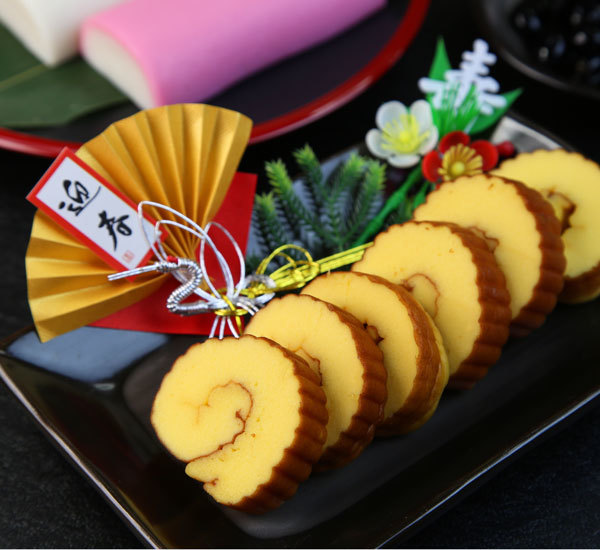
Datemaki: Meaning Scholarship since it resembles a scroll for study and culture. Ingredients are similar to Tamago-yaki (sweetened fried eggs) but mixed with fishcake to make it extra fluffy.
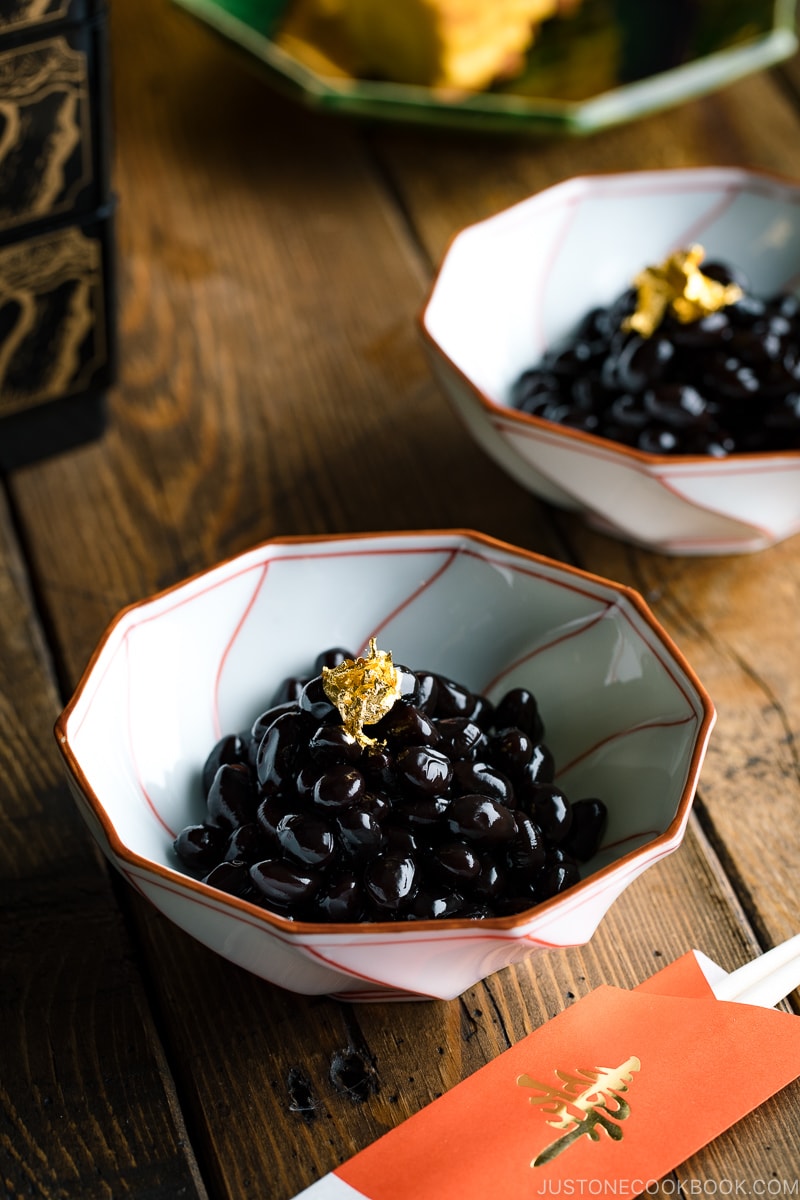
Kuromame: Meaning Health ‘Mame’ (beans) in Japan resemble health, but black beans resemble fighting off evil spirits. Ingredients are straightforward, sweeten black beans by stewing in a sugary sauce.

Kuri-Kinton: Meaning Wealth Sweet Chestnuts cooked down into a yellowish color resembles gold which then resembles wealth. Ingredients are chestnuts but sweetened with sugar, decadent and perfect for that sweet tooth.
Ebi: Meaning Longevity Shrimp are tough little guys with hard spiny shells and, therefore, resemble longevity. The red color also adds brilliant presentation appeal to the bento boxes, which is very important in Japan. Ingredients, Shrimp, but quality differs depending on how much you are willing to fork out for those nicer ones.
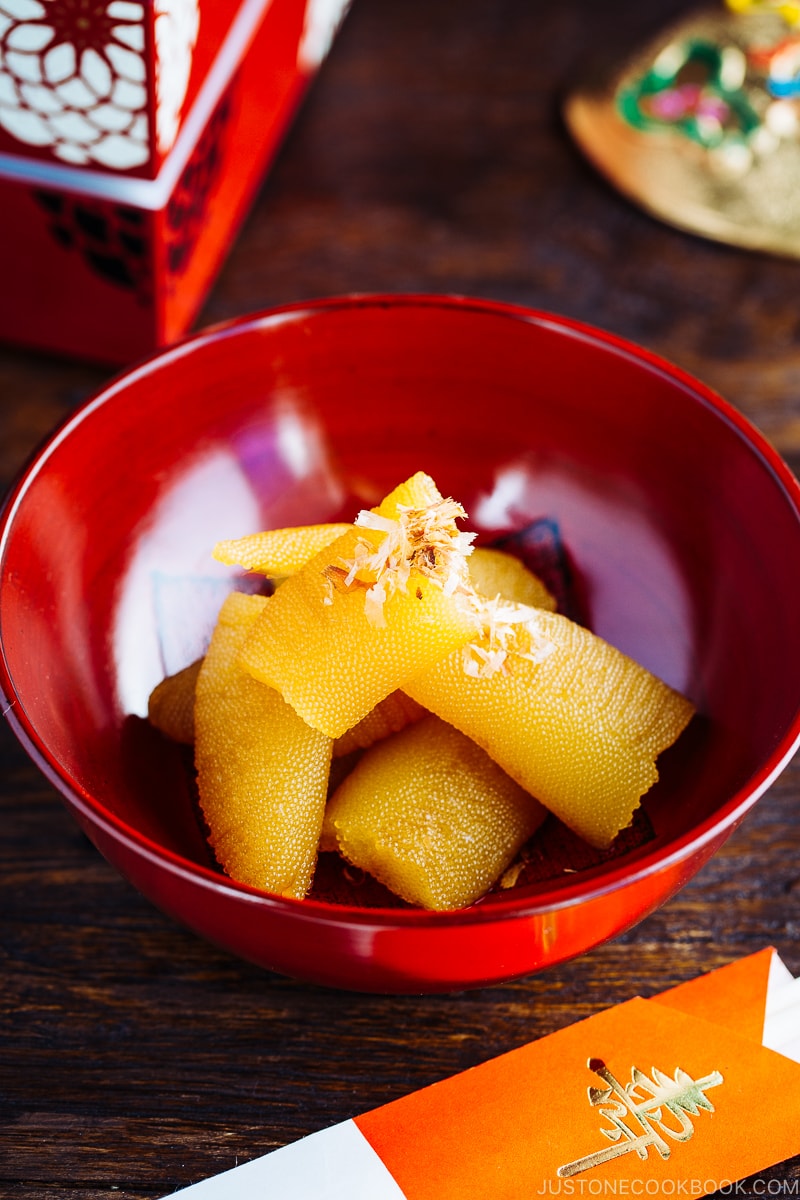
Kazunoko: Meaning Fertility Herring Roe ‘Kazunoko’ translates to ‘many children’ and symbolizes a blessed and prosperous family. Ingredients are golden roe from the herring fish and typically marinated in soy sauce, dashi, and possibly mirin (each family has its way of preparing it)
There are many more dishes in Osechi Ryori, and thankfully, you can order your boxes from a restaurant or specific Osechi company these days. Now they do not come cheap, Japan only uses the best ingredients, and presentation for these boxes is crucial. Wishing for wealth, health, and happiness is not taken lightly.
Places you can order from: https://gurusuguri.com/cat/01110010000/?__ngt__=TT1286c3ce2004ac1e4ae827uNIgWoqD7R4eihQBP8vm6Z
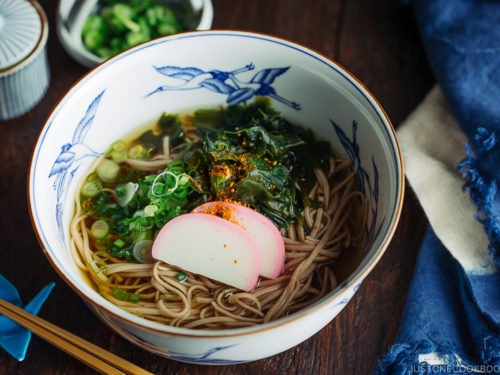
2. Toshikoshi Soba
How do you countdown the New Year? With a delicious hot bowl of soba noodles. Not only does it taste delicious, but yet again, there is meaning to it. Toshikoshi or ‘Year-Crossing’ noodles resemble cutting off the old Year. A new start, getting rid of your old ties and not carrying them over to the new Year. What makes soba unique to use and not ramen or somen? Noodles in Japan resemble longevity with their long shape and chewy textures. Yet, soba specifically is a hardier noodle relating to resilience but easily bitten off when chewed to ‘cut-off’ from old ties. Eat these noodles before or after the countdown, but make sure not to eat them during.
Ingredients: You can eat them hot or cold. You can find a simple dish of Soba (buckwheat noodles) and Mensuyu (noodle broth) at the grocery store. Even easier, buy cup-soba, and all you need to do is add hot water to it.
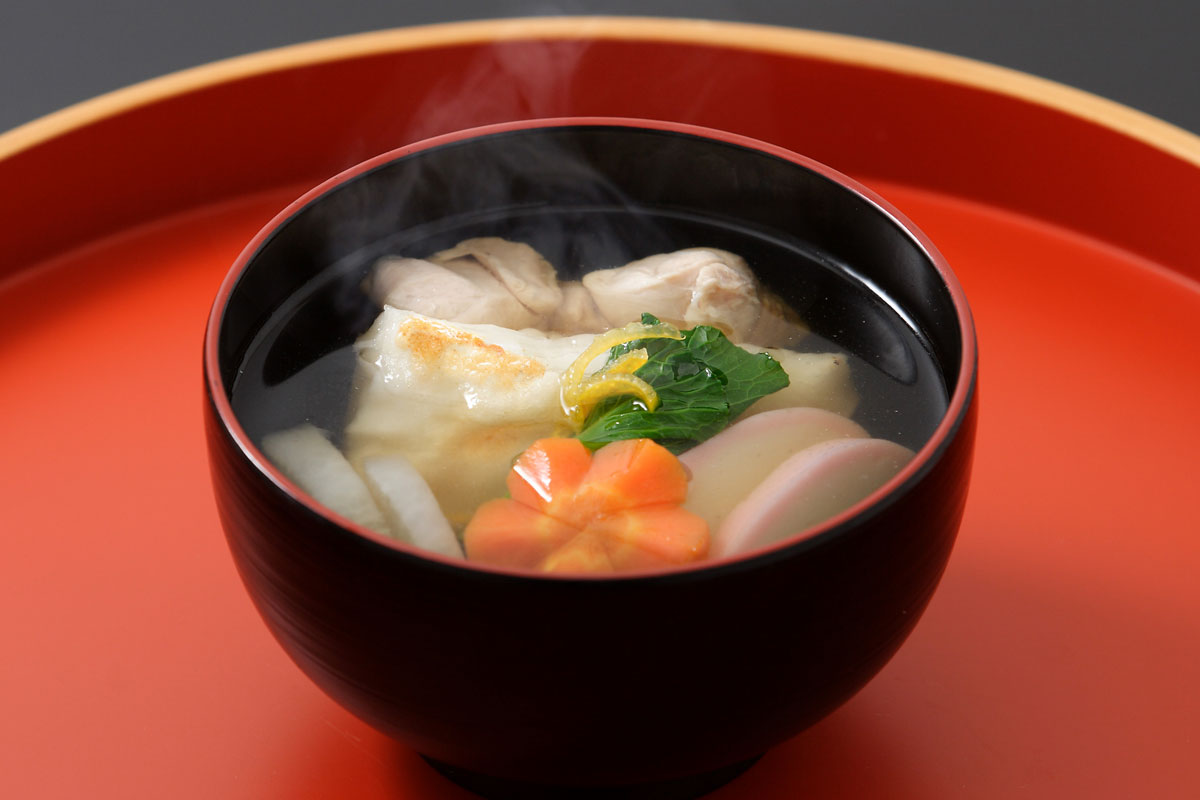 3. Ozouni
3. Ozouni
New Year tends to be cold, so a hot bowl of mochi soup is just what you need. Each region, and even each household, has its own spin on Ozouni, differing between the type of meat, the base of the soup being either miso or soy sauce, and what toppings you add. The soup’s star, though, is the toasted mochi found inside. A delicious twist is adding slices of Yuzu peel or seaweed flakes.
You can find all the ingredients at your local grocery store. Here is a recipe if you would like to give it a try https://www.justonecookbook.com/ozoni/
4. Mochi
Mochi, or sticky rice cakes, are enjoyed all Year long but showcased during the New Year holidays. Mochi is sticky rice, called mochigome, pounded until it turns into a sticky chewy ball. There are many ways to prepare it, but a few favorites are toasting mochi, dipping it in soy sauce, and wrapping it with seaweed. Another is eating it with kinako powder and drizzling it with Kuromitsu (black sugar syrup). The most noticeable over the New Year is Oshiruko.
5. Oshiruko
Using mochi, Oshiruko is a sweet bean soup dessert with a thick piece of mochi in the center. Anko, or red beans, is another staple ingredient in many Japanese desserts and is usually used alongside mochi.
The recipe consists of red beans slowly cooked in sugar and then topped with a toasted piece of mochi. You can find these ingredients at any local grocery store and even convenience stores. Just grab a can of red beans, heat it, add more sugar if needed, and add your toasted piece of mochi! Simple and sweet.
6. Amazake
It is a sweet and hot fermented rice drink. Amazake translates into ‘Sweet Sake’ and is another one of Japan’s ‘superfoods’ or ‘superdrinks’ we should say. Said to help boost energy and promote brain function. When it comes to health and food, Japan does it right. Not only is it healthy, but it’s delicious and keeps you nice and toasty. Buy pre-packaged at your local grocery store.
Living in Japan, you learn to appreciate each season, and with the seasons comes seasonal foods. At first, you might be sad when the sweetest Muscats you’ve ever tasted disappear from the grocery shelves, but what fills its places are the next best seasonal items. Winters specialties are Mikans, sweet peelable tangerines.
Another fantastic seasonal food that appears on the shelves in Winter is Nabe soup. Nabe is Hot Pot with pre-made broth that you pour into your pan and top with your favorite vegetables and meat.
Lastly, Oden; another Winter staple that is simple, delicious, and convenient. Oden is a variety of vegetables, fish cakes, hard-boiled eggs, sausages, and more boiled in a delicate dashi broth. You can easily find these at all convenience stores.
If you are fortunate to be in Japan during the New Year, take advantage of embracing the whole experience. Food brings people together, and nothing is better than spending the holidays gathered around the table eating foods that have stood the test of time! So get cooking or shopping, and have a Wonderful New Year. We are wishing you all the best this holiday season from Apts.jp!
